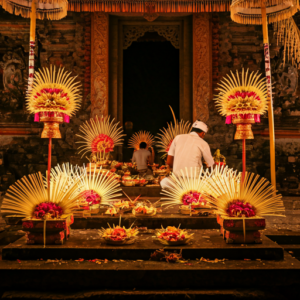
Traditional Balinese puppetry, known as „Wayang Kulit,“ is a cornerstone of Balinese culture, blending intricate artistry with deep-rooted storytelling traditions. This ancient form of shadow play has been performed for centuries, captivating audiences with its magical combination of light, shadow, and sound. Through Wayang Kulit, Balinese puppeteers, or „Dalang,“ convey complex narratives, moral lessons, and religious teachings, making it a vital part of Bali’s cultural and spiritual heritage.
Historical Origins and Evolution
Wayang Kulit has its origins in the ancient Javanese Hindu-Buddhist culture, with evidence suggesting it was established in Java as early as the 10th century. When Hinduism and Buddhism spread to Bali, Wayang Kulit was adopted and transformed, incorporating Balinese aesthetics and spiritual elements. Over the centuries, it has evolved to include influences from local folklore, Hindu epics, and contemporary issues, reflecting the dynamic nature of Balinese culture.
The Dalang: Master Storytellers and Puppeteers
The Dalang is the central figure in Wayang Kulit, serving as the master puppeteer, storyteller, and spiritual guide. This role requires years of rigorous training, not only in manipulating the intricate leather puppets but also in memorizing extensive storylines, mastering various character voices, and understanding the spiritual and philosophical messages embedded in the performances.
Dalangs are highly respected figures in Balinese society, often regarded as both entertainers and spiritual leaders. They perform a crucial role in preserving and transmitting cultural knowledge, using their art to educate, inspire, and maintain social harmony. The training of a Dalang typically begins in childhood, with apprenticeships under experienced masters, ensuring that the skills and knowledge are passed down through generations.
The Art of Puppet Making
The puppets used in Wayang Kulit are handcrafted from water buffalo hide, meticulously carved and painted to create intricate designs. Each puppet can take several weeks to complete, requiring a high level of skill and patience. The puppets are mounted on bamboo sticks and articulated with movable limbs, allowing the Dalang to animate them during performances.
The characters in Wayang Kulit are easily identifiable by their distinct shapes, colors, and facial features, which signify their moral and emotional attributes. For instance, noble characters are depicted with refined, delicate features and are often painted in light colors, while antagonistic characters have exaggerated, grotesque features and darker tones. This visual symbolism helps the audience immediately recognize the nature of each character.
Stories and Themes
The narratives in Wayang Kulit are primarily drawn from Hindu epics like the „Mahabharata“ and the „Ramayana,“ as well as local Balinese folklore and legends. These stories are rich in moral and philosophical teachings, often exploring themes of good versus evil, duty, loyalty, and the complexities of human nature.
- The Ramayana
One of the most popular sources for Wayang Kulit performances is the „Ramayana,“ the epic tale of Prince Rama’s quest to rescue his wife Sita from the demon king Ravana. This story is celebrated for its exploration of righteousness, devotion, and the triumph of good over evil. In Balinese performances, the characters of Rama, Sita, Hanuman, and Ravana are brought to life with elaborate puppets and dynamic storytelling.
- The Mahabharata
The „Mahabharata,“ another cornerstone of Wayang Kulit, narrates the epic struggle between the Pandavas and the Kauravas, two branches of a royal family vying for the throne. This epic is complex, dealing with themes of justice, morality, and the consequences of one’s actions. Key episodes, such as the „Bhagavad Gita,“ are often performed to impart spiritual lessons to the audience.
- Local Folklore
In addition to these epics, Wayang Kulit often incorporates stories from local Balinese folklore, featuring gods, demons, and mythical creatures unique to the island’s culture. These stories are integral to communal rituals and celebrations, reinforcing local traditions and values.
The Performance: A Fusion of Art and Ritual
A Wayang Kulit performance is a sensory experience, combining visual artistry, music, and narration. The Dalang sits behind a white screen (kelir), illuminated by a flickering oil lamp (blencong), which casts the shadows of the puppets onto the screen. This setup creates a mystical atmosphere, with the shadows dancing to the accompaniment of a traditional gamelan orchestra.
The gamelan orchestra, an essential component of Wayang Kulit, comprises various percussion instruments, including metallophones, xylophones, drums, and gongs. The music sets the mood, accentuates the action, and provides cues for the Dalang. The coordination between the Dalang and the musicians is crucial, as it enhances the dramatic impact and emotional resonance of the performance.
Symbolism and Spiritual Significance
Wayang Kulit is not merely entertainment; it holds profound spiritual significance. Each performance is a symbolic journey, reflecting the cosmic struggle between good and evil, the balance of the universe, and the pursuit of dharma (righteousness). The characters and their actions are allegories for human virtues and vices, and the moral dilemmas they face are intended to provoke introspection and ethical contemplation among the audience.
The shadow play aspect of Wayang Kulit itself symbolizes the duality of existence, with the light and shadows representing the seen and unseen aspects of reality. This duality is central to Balinese Hindu philosophy, which emphasizes harmony and balance between opposing forces.
Rituals and Community Involvement
Wayang Kulit is deeply integrated into the religious and social life of Balinese communities. Performances are often held in conjunction with temple ceremonies, festivals, and important life events such as weddings and funerals. These events are not only opportunities for communal entertainment but also for collective reflection and spiritual renewal.
The community’s involvement in Wayang Kulit extends beyond the audience. Villagers often participate in the preparation of performances, from crafting puppets and musical instruments to setting up the performance space. This collective effort reinforces social bonds and fosters a sense of shared cultural heritage.
Preservation and Modern Adaptations
Despite its ancient origins, Wayang Kulit continues to thrive in contemporary Bali, adapting to modern contexts while preserving its traditional essence. Efforts to preserve this art form include educational programs, cultural festivals, and support from government and non-governmental organizations.
- Educational Programs
Various initiatives aim to teach the younger generation about Wayang Kulit, ensuring the continuity of this tradition. Schools and cultural centers offer workshops and training programs in puppetry, storytelling, and gamelan music. These programs not only preserve the technical skills involved but also impart the cultural and spiritual values embedded in Wayang Kulit.
- Cultural Festivals
Cultural festivals, both in Bali and internationally, play a significant role in promoting Wayang Kulit. These festivals provide platforms for Dalangs to showcase their art to diverse audiences, fostering appreciation and understanding of Balinese culture. They also offer opportunities for cross-cultural exchanges, where Balinese puppetry can be seen in dialogue with other traditional and contemporary art forms.
- Modern Interpretations
While traditional Wayang Kulit remains central, modern interpretations and innovations have emerged, reflecting contemporary themes and artistic experimentation. Some Dalangs incorporate new stories, including social and political issues, making the performances relevant to today’s audiences. Others experiment with multimedia elements, combining traditional puppetry with modern technology to create new forms of expression.
Conclusion
Traditional Balinese puppetry, or Wayang Kulit, is a profound expression of Bali’s cultural and spiritual heritage. Through the artistry of shadow play and storytelling, it conveys timeless narratives, moral lessons, and philosophical insights that resonate with audiences across generations. The Dalangs, with their mastery and dedication, keep this tradition alive, ensuring its relevance in a changing world.
As Bali continues to navigate the complexities of modernity, Wayang Kulit stands as a testament to the island’s rich cultural legacy. It reminds us of the enduring power of storytelling, the importance of preserving traditional arts, and the deep connections between art, spirituality, and community. Through the shadows cast by its puppets, Wayang Kulit illuminates the essence of Balinese identity and the universal themes that unite us all.





